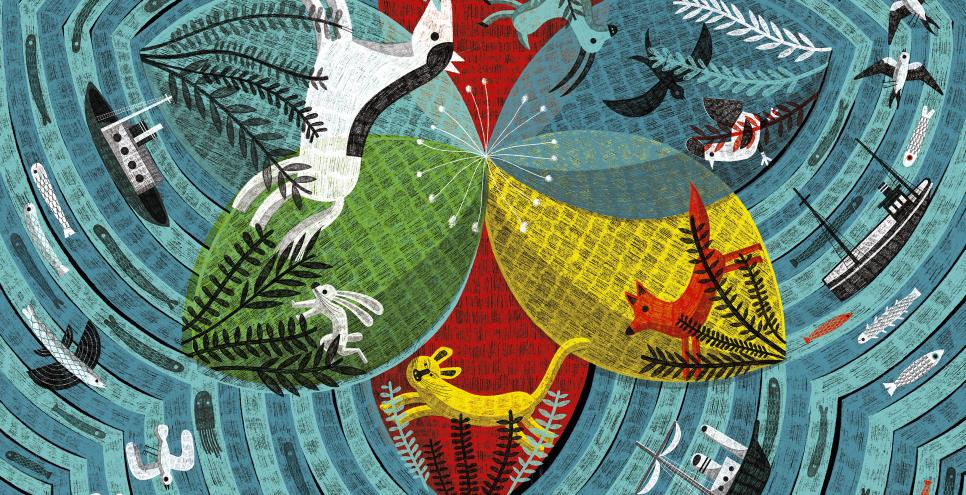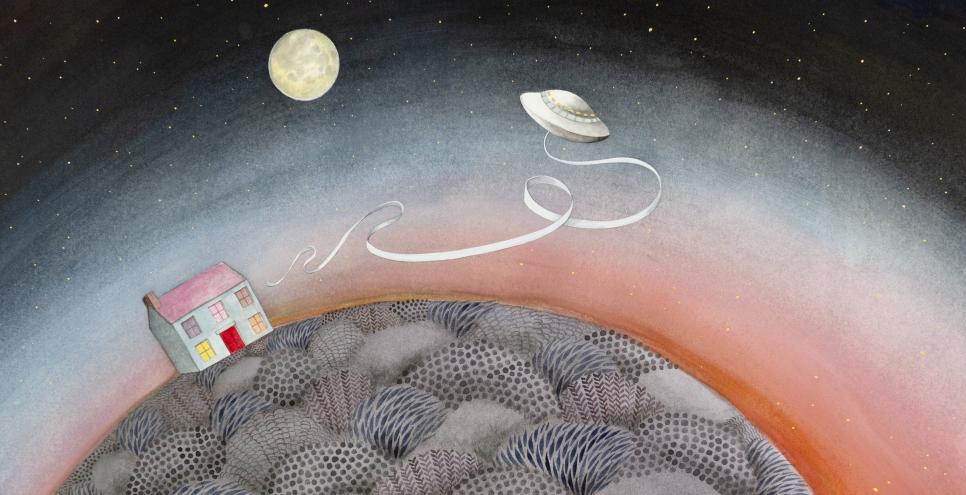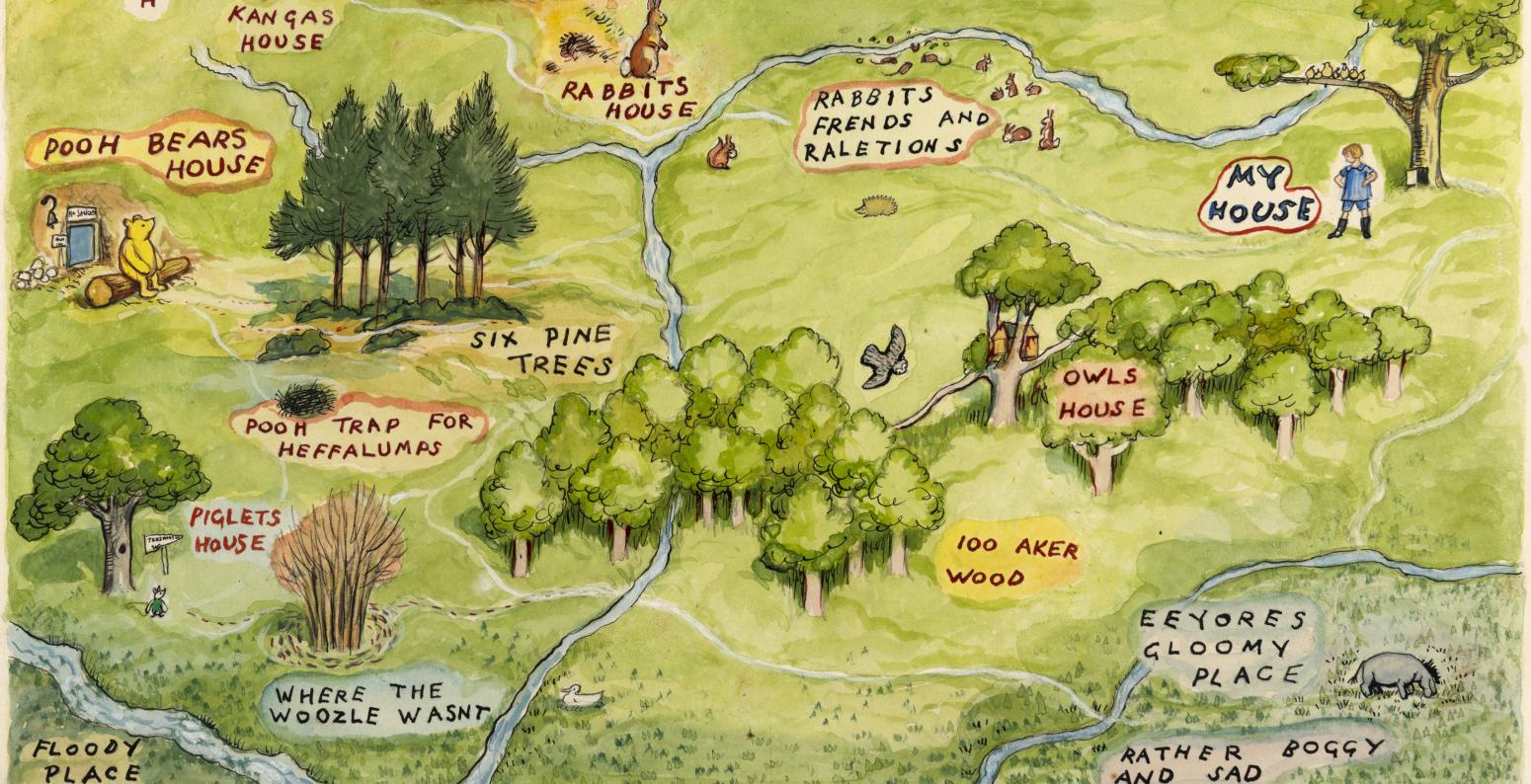
E. H. Shepard, Illustration for The World of Pooh by A. A. Milne. Courtesy of Penguin Young Readers Group, a division of Penguin Random House, LLC. © 1957 E. P. Dutton & Co., Inc.
Explore the Unsung Creativity of Endpapers
Open + Shut: Celebrating the Art of Endpapers
Guest Curator: Bruce Handy
On View April 19 – November 9, 2025
An exhibition at The Carle explores the often-overlooked creativity of endpapers—the decorated pages inside a book’s covers—which have become an expanded artistic canvas in contemporary children’s publishing. Open + Shut: Celebrating the Art of Endpapers features art from more than 50 books, ranging from classics such as Blueberries for Sal and The World of Pooh, to three decades of contemporary works by Sophie Blackall, Yas Imamura, Eliza Kinkz, Grace Lin, Jessica Love, Jerry Pinkney, Paloma Valdivia, and others.
Endpapers are the pages pasted inside the front and back covers of hard-bound books, helping to bind the rest of the pages to the cover. For artists and designers, endpapers can be a gloriously blank canvas, setting the mood for the story inside with images full of wit, surprise, and deep emotion. Open + Shut will explore how endpapers can tell a story within a larger story; frame or comment on the main story; serve as a warm-up act or overture; or provide extra information, almost like a visual introduction or epilogue.
“I think of endpapers as the picture book equivalent of a movie or TV show’s title and credits sequence, or a tempting appetizer at the start of a meal plus a sweet dessert at the end. In the digital age, they give us yet another reason to cherish the pleasures of physical bookmaking – and reading,” said Bruce Handy, Open + Shut guest curator and author.
“At The Carle, we take pride in uncovering hidden stories and revealing new ways to experience picture book art,” said executive director Jennifer Schantz. “Open + Shut lifts the veil on endpapers, an aspect of picture books that readers rarely think to see, showcasing its essential role in shaping the art and storytelling of the picture book.”
Open + Shut explores four distinct, though often related, approaches to endpapers:
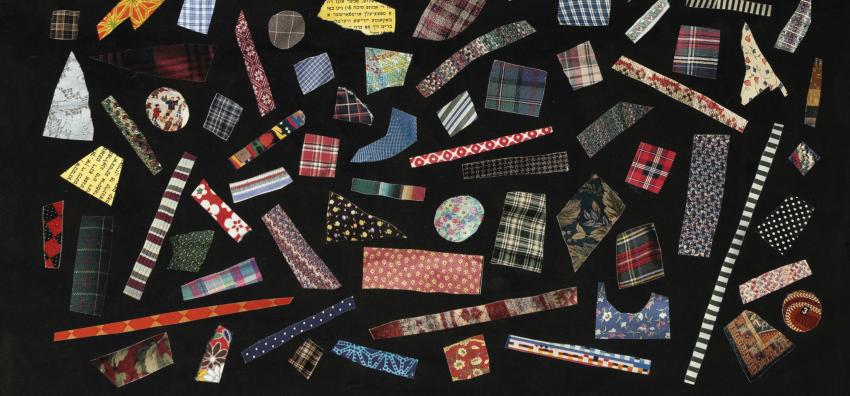
The Decorative Tradition
The endpapers of 18th and 19th century books were often purely decorative marbled papers, until illustrators in the early 20th century began adding eye-catching drawings, paintings of central characters, or scene-setting landscapes. Examples paying homage to the decorative tradition include Virginia Lee Burton’s The Song of Robin Hood (1947), with a repeated wavy pattern of Robin Hood in Sherwood Forest, and Ed Emberley’s ABC (1978), with vibrant hand-drawn swirls of green, purple, and orange.
Ashley Bryan’s endpapers for Beautiful Blackbird (2003) introduce colorful African birds and feature scissors that, he writes, “are the scissors that my mother used in her sewing and embroidery and that I, in turn, used in cutting the paper for the collages in this book.” Another collaged endpaper on view is Simms Taback’s Joseph had a Little Overcoat (1977), an illustration made from scraps of old photographs, patterned papers, and other elements. Taback’s resourcefulness reflects the story of Joseph, who fashions a jacket from his old overcoat, then a vest from the worn jacket, and so on, until all that remains is a handkerchief and a button.

Brendan Wenzel, Illustration for Inside Cat (Chronicle Books). Collection of Brendan Wenzel. © 2021 Brendan Wenzel.
Maps, Landscapes, and Stage Sets
Open + Shut shows how books exploring imaginary lands often feature endpapers with a map or landscape to geographically orient the reader. A classic image on view is E.H. Shepard’s childlike map of the Hundred Acre Wood, featured in the endpapers of A.A. Milne’s The World of Pooh (1957), which sets the scene for the tales to follow. The front endpaper of Brendan Wenzel’s Inside Cat (2021) captures the limited, house-bound perspective of his title character, whereas the back endpaper completes the hero’s transformation into an outdoor cat—one who can embrace an entire city.
Emotional landscapes also can be evoked through endpaper imagery, such as the kingdom depicted in the endpapers of Jerry Pinkney’s The Lion and the Mouse (2009). The artist noted he set the work “in the African Serengeti of Tanzania and Kenya, with its wide horizon and abundant wildlife so awesome yet fragile—not unlike the two sides of each of the heroes.” Yas Imamura’s poignant art for Love in the Library (2022, written by Maggie Tokuda-Hall) depicts a beckoning western landscape separated from the viewer by a barbed wire fence—a lovely yet heartbreaking visual metaphor for a true story about life in a World War II Japanese-American internment camp.
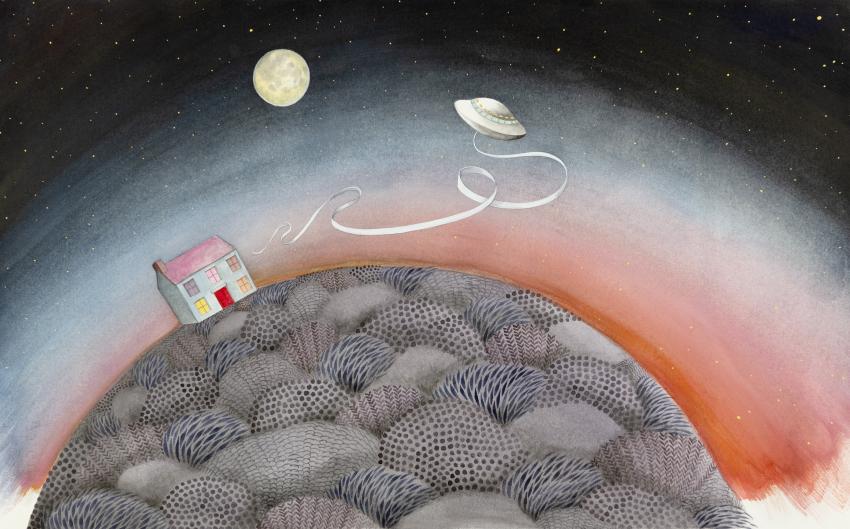
Sophie Blackall, Illustration for If You Come to Earth (Chronicle Books). Collection of the artist. © 2020 Sophie Blackall.
Before & After
Stories are often about change, and artists can visually encapsulate these changes in the endpapers, with some providing a prologue or epilogue beyond the narrative. Sophie Blackall’s If You Come to Earth (2020) takes the form of a letter, written by a child: “Dear Visitor from Outer Space. If you come to Earth, here’s what you need to know.” Although the story does not say if the letter was ever received, the endpaper suggests an answer, as a UFO arrives above the house. Jessica Love’s narrative of Julián Is a Mermaid (2018) begins with the front endpaper, which depicts the young hero enjoying his weekly Saturday morning swim with his abuela and her friends. Love’s back endpaper is a poetic conclusion to Julián’s story of self-discovery, as everyone in the pool has been transformed into beautiful mermaids.
Paloma Valdivia’s endpapers for Pablo Neruda’s Book of Questions (2022) suggest a modern riff on medieval illumination. The front endpaper presents a hierarchical, well-ordered world of animals, and on the back endpaper, everything is mixed up—a before-and-after visual metaphor for how Neruda’s subversive philosophical questions reorder preconceptions.
Robert McCloskey, Book dummy illustration for Blueberries for Sal (Viking). Courtesy of The May Massee Collection, Emporia State University Special Collections and Archives, Emporia State University. © 1948 Robert McCloskey.
Wit, Wisdom, and Surprise
Open + Shut also shows how some artists add an extra layer of fun or meaning in the endpapers for close readers. A preliminary sketch on view from Robert McCloskey’s Blueberries for Sal (1948) shows the iconic scene of mother and daughter canning blueberries in the family kitchen—a coda to the story’s main events. Grace Lin’s endpapers for A Big Mooncake for Little Star (2018) pay homage to Blueberries for Sal, connecting the traditions of her contemporary Chinese-American kitchen to McCloskey’s older New England archetype, with a wink for close readers: figurines of a mother bear and cub on a shelf.
Eliza Kinkz’s endpapers for Papá’s Magical Water-Jug Clock (2023, written by Jesús Trejo) feature a series of trading cards for made-up Mexican wrestlers with gardening powers, such as “El Weeder” and “Captain Rake.” A playful riff on hero worship, the cards serve as a witty addendum to this autobiographical story about Trejo spending a Saturday working with his father, a gardener.
Programming
The Carle will host a Curator Tour with Bruce Handy of Open + Shut: Celebrating the Art of Endpapers on April 19 at 1 pm.
About Bruce Handy
Guest curator Bruce Handy is a journalist, critic, humorist, and children’s book author. His work has appeared in The New Yorker, Vanity Fair, The New York Times, and The Atlantic, among other publications. His book Wild Things: The Joys of Reading Children’s Literature as an Adult was published in 2017. His history of teen movies, Hollywood High, will be published this May. He is also the author of five picture books, three of which have been named New York Times Best Children’s Books, including The Happiness of a Dog with a Ball in Its Mouth and What If One Day…. He began his career as a writer and editor at Spy magazine, and also spent a season (1992–1993) writing for Saturday Night Live.
About The Eric Carle Museum of Picture Book Art
Founded by Eric and Barbara Carle in 2002, The Eric Carle Museum of Picture Book Art is the international champion of picture book art. Situated on 7.5 acres in Amherst, Massachusetts, The Carle houses a rich and deep collection of art of more than 300 picture book artists, including Eric Carle (author ofThe Very Hungry Caterpillar), and illuminates its collection through exhibitions, education, programming, and art-making—making it a critical resource for picture book artists and authors, and art-loving communities locally, nationally, and abroad. The Carle’s mission is to elevate picture book art and inspire a love of art and art creation. Since opening its doors more than 20 years ago, The Carle has welcomed more than one million visitors—plus more than four million additional museumgoers who have enjoyed its touring exhibitions around the world.
For further information, please contact: Amanda Domizio, Amanda Domizio Communications, 347-229-2877 / amanda@domiziopr.com

